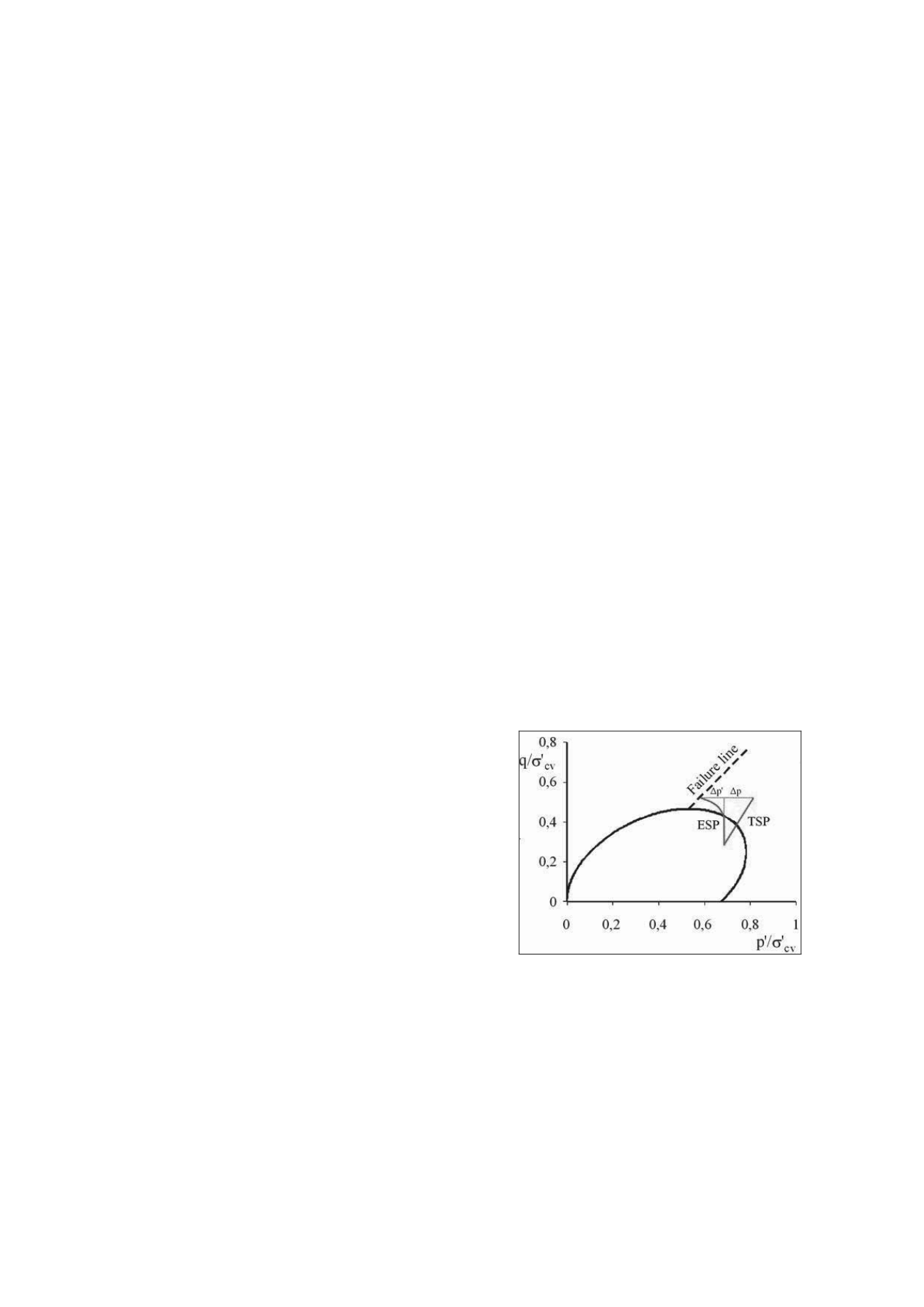
755
Two methods for estimating excess pore pressure in LEM
Deux méthodes pour estimer l’excès de pression interstitielle
Lehtonen V., Länsivaara T.
Tampere University of Technology
ABSTRACT: Two methods for estimating excess pore pressure in undrained effective stress LEM calculations are presented. The
new methods take into account the excess pore pressure from undrained yielding of clay, which traditionally has been difficult to
model without the use of FEM. The method ru’ calculates yield-induced excess pore pressure based on an initial yield surface. The
work-in-progress method MUESA also takes into account factors such as overconsolidation and non-triaxial stress states. The paper
also discusses the implicit overestimation of shear strength in undrained effective stress calculations. It is suggested that failure state
pore pressure is universally used in the calculations to obtain a theoretically more sound definition of the factor of safety (F). The new
definition of F is also compatible with φ = 0 stability calculations. A calculation example is presented.
RÉSUMÉ:
Cet article présent deux méthodes pour estimer l’excès de pression interstitielle de porosité dans les calculs LEM d’un
espace fermé. Les nouvelles méthodes tiennent compte de l'excédent de pression interstitielle dans la production non drainée de
l'argile, ce qui a toujours été difficile à modéliser sans l'utilisation d'éléments finis. La méthode ru’ calcule le rendement induit par
excès de pression interstitielle reposant sur une surface d'élasticité initiale. Le méthode de travail MUESA en cours tient également
compte des facteurs tels que la surconsolidation ainsi que les états de contrainte non triaxiaux. Le document étudie également la
surestimation implicite de la résistance au cisaillement non drainé dans les calculs de contraintes effectives. Il est suggéré que l’état
des pressions interstitielles défaillantes est universellement utilisé dans les calculs dans le but d’obtenir une définition théoriquement
plus solide du facteur de sécurité (F). La nouvelle définition de F est également compatible avec les calculs de stabilité φ = 0.
L’article propose un exemple de calcul.
KEYWORDS: stability, pore pressure, modeling, LEM, clay, embankment
1
INTRODUCTION
In this paper two methods of modeling excess pore pressure in
undrained effective stress LEM calculations are presented. The
theoretical grounds leading to an overestimation of shear
strength are discussed.
In Finnish practice embankment stability on clayey subsoils
is commonly calculated using undrained shear strength (s
u
)
measured with vane shear testing. This often results in
unrealistically low factors of safety, which underestimates the
safety and causes problems in directing stability improvement
measures. The problem mostly lies in uncertainties in
determining of s
u
.
In undrained effective stress analyses the uncertainty in
parameters is generally smaller, but the problem lies in the
estimation of pore pressure at failure state. In limit equilibrium
(LEM) calculations the yield induced pore pressure is usually
totally disregarded, which then results in an overestimation of
safety. In finite element (FEM) analysis yield induced pore
pressure is possible to account for, but it requires the use of
quite advanced soil models and proper understanding of the
influence of model parameters on the development of pore
pressure.
It is thus recognized that there is a need for effective
engineering tools that account for the yield induced pore
pressure in a simple LEM calculation.
2
THEORETICAL BACKGROUND
The excess pore pressure response of soft clay is a complex
process with many affecting factors such as the stress history of
the clay, rate and direction of loading, structural anisotropy etc.
The excess pore pressure response of clay can (conceptually)
be divided into two components Δp and Δp’, which represent
changes in total mean stress and effective mean stress,
respectively (Figure 1).
Figure 1. Components of excess pore pressure in (p’, q) space.
The total stress component Δp represents excess pore pressure
caused by a change in the total stress state of the soil element.
As the clay is in undrained state and the total volumetric strains
equal to zero (assuming isotropic elasticity), the excess pore
pressure component is equal to change in total mean stress Δp.
When clay is yielding in the undrained state there will also
be a pore pressure component Δp’ that is caused by the
reorganizing of the clay structure. Normally consolidated or
lightly overconsolidated soft clays usually have a tendency for
volumetric compression while yielding. In the undrained state
this must be offset by excess pore pressure (again due to the
assumption of zero volumetric strains).
In constitutive soil models it is often assumed that for
overconsolidated clays the stress-strain response is elastic, i.e.


